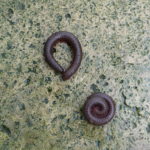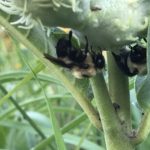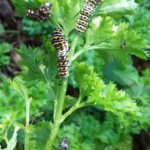by Winding Pathways | Oct 31, 2019 | Bugs, Garden/Yard, Nature

Millipedes are ancient creatures
Many people discovered one of the oldest types of animals in their yards and homes this year. Millipedes. Usually common they have been especially visible in this humid rainy summer and fall.
Millipedes have been around for millions of years doing the world a service. Biologists call them detritivores, which simply means they eat bits of decaying leaves, grass, feces, and other organic matter found nearly everywhere. Scientists call dead material of many origins detritus. To millipedes it’s dinner.
About 12,000 species of millipedes live around the world on all continents except Antarctica. They range from about a quarter-inch to several inches long and most are brown or black. All have two pairs of legs on each body segment. Since they have many segments millipedes have enormous numbers of legs stretching down each side of their body. That doesn’t make them speedsters. Millipedes creep along.
Few animals are as harmless as millipedes. They can’t bite or sting. When threatened millipedes roll up in a ball and play possum, but normally they avoid predators by hiding in detritus or under rocks and logs. Snakes, amphibians, and birds enjoy snacking on them.
Millipedes are sometimes confused with centipedes, but they are distinctly different. Millipedes are sluggish consumers of dead plants while centipedes are swift predators. Both enter homes through cracks and holes in the walls or gaps in doors and windows. Caulking is an effective way to keep them outside.
Millipedes may seem creepy to some people but they have survived for millions of years recycling dead plant material into humus. They deserve our respect.

Can you count the millipede legs?
Answer: Millipedes take so long to lace up their shoes that the race is over by the time they finish.
by Winding Pathways | Aug 29, 2019 | Birds, Bugs, Flowers/Grasses, Garden/Yard, Nature
On a sunny, warm, late summer day we watched countless bees and butterflies foraging on prairie plants, hummingbirds sipping nectar from Cardinal flowers, and small birds pausing to drink water on the cup plants. That evening, bats swooped across the sky as clouds gathered. Then, came the downpour.
So, we wondered, where do birds and bees and bats go during storms or just to rest? A bit of Internet searching yielded some fascinating information.
Bees

seeking shelter from the rain
Bees are active in the day and need sleep just like humans do. How they sleep is quite different. Bees and many insects do not have eyelids. They relax the body and antennae and sometimes fall over. Sometimes, the other bees in a honeybee colony prop up the “sleeping” bee. As we see in this video, and similar to human babies, they sleep in shorter bursts. This sleep helps their memory. Remember, bees, especially honeybees explore new foraging spots, return to the hive, communicate through a “dance” telling other bees where the source of nectar is. As with people, good sleep helps them perform better. Look for bees on the underside of leaves and grass blades after a rain or in the early morning.
Butterflies
Butterflies also seek shelter on the underside of leaves or grass blades. This vegetation protects them from furious winds and debilitating raindrops. Think about it! How delicate a butterfly’s wings are and how a large raindrop can punish it. A Scientific American article gave a great comparison to us humans – being whacked by a water balloon twice the mass of a bowling ball!
Birds and Bats

One hummingbird fell into a torpor on the feeder!
To rest, Hummingbirds go into torpor – a sleep-like state where the body temperature drops to conserve energy. They sometimes hang upside down as we see in this video. When the temperatures rise, they “wake up”. They can fly in moderate rains.
Some larger birds, like turkeys, actually come out in rainstorms and forage on insects that are slowed down by the cooler temperatures. At night, turkeys roost in trees. Watching them navigate through dense forests into the tops of sturdy trees is amazing.
Nighthawks, along with their nocturnal companions bats, find daytime shelter on tree branches. Bats tuck under tree bark flaps, in crevices and caves, and enter tiny cracks in homes making attics a cozy den.
Next time you are out and about, look carefully on undersides of leaves and grass blades, study branches of trees for unusual shapes that might be a roosting bird, and notice animals out and about at different times of the day and in different weather.
by Marion Patterson | May 9, 2019 | (Sub)Urban Homesteading, Bugs, Foraging, Garden/Yard, Nature, Uncategorized
A delightful swatch of color flitted by as we sat on our back deck on one of spring’s first warm sunny days. It was a red admiral butterfly that landed on a post just a few feet from us. It appeared to be enjoying the weather as much as we were.
We’ve since spotted many red admirals in the yard, probably because stinging nettles thrive on the north end of our property. It’s the favored plant for red admiral caterpillars, although they’ll also live on other types of nettles. That poses somewhat of a dilemma.
What is a Red Admiral Butterfly?

These colorful butterflies depend on early blooming plants like nettles.
Red Admirals are a common butterfly across much of the temperate globe. They’re found across Europe and Asia, North Africa, Hawaii, and much of North America, especially the eastern half of our continent. The larvae feed on stinging nettles, which may not be native. So, if red admirals need stinging nettles what did they eat before the plant was introduced to North America in the early days of European exploration? It’s not even certain that stinging nettles are exotic. They may have been here all along, or early butterflies may have fed on wood nettles.
We appreciate both the insect and plant here at Winding Pathways. Red admirals add color and movement to the yard, while nettles make delicious eating. It’s the first wild green we harvest each early spring.
Can You Eat Nettles?

Carefully pluck the top three leaves off.
Stinging nettles are ready to harvest early – about the time when chard, spinach, and lettuce are planted. When the nettles are just a few inches tall we pluck off the top three or four leaves. They are called stinging nettles because the plant has tiny hairlike stingers. Walk through a patch in summer wearing shorts and nettles cause instant pain. But it’s temporary and not dangerous. Another name for the plant is the “seven-minute itch.” The sting comes from histamines.
We gather young nettles without getting stung by carefully plucking just the top leaves between our thumb and forefinger and snapping them off. About 100 young nettle tops make two servings. We bring them into the kitchen, rinse them a couple of times, and steam them for just a minute or two. The sting disappears and resulting greens are delicious. Plus they pack a nutritious array of vitamins and are high in protein.
Nettle season is short. By the time the plants are eight or ten inches tall, the new leaves are getting tough. But by then we’re harvesting chard and spinach from the garden.
We’re happy to share our yard with both red admirals and nettles. Anyone with a partly shady yard with damp soil might want to start a nettle patch. Wear a pair of gloves and dig up a few and plant them in the yard. They aren’t fussy and will provide excellent table fare and a higher likelihood that the yard will be home to the colorful butterfly.
by Winding Pathways | Nov 15, 2018 | (Sub)Urban Homesteading, Bugs, Flowers/Grasses, Garden/Yard, Garden/Yard, Nature

Butterfly on plant
This past summer we enjoyed watching many monarch butterflies flutter over our prairie labyrinth. Numbers were way up from last year.
These intrepid insects are now en route to wintering grounds in Mexico. We look forward to their return next year.
Monarchs suffered huge population declines due to varied stresses on their lives. In farm country, most fencerows, waterways, and pastures that once harbored milkweed and wildflowers that provided both caterpillars and adults with food have disappeared. Today’s farmland is a pesticide-laced monoculture of just a few crops.
In town, manicured and sprayed lawns are as devoid of diversity as a cornfield and can’t sustain beautiful wildlife like butterflies.
The news would be more distressing had people not responded with enthusiasm to the monarchs’ decline. This summer we were delighted to see dozens of homeowners in Cedar Rapids and other towns let their lawns grow taller. Many planted pollinator patches in even tiny yards that include a diversity of native plants, including milkweeds. We took joy in seeing a small patch of milkweeds nurtured by the staff of a convenience store in a tiny patch of dirt near the gas pumps.

Grow a wild patch on your lawn to encourage butterflies.
Every pollinator patch, even if tiny, adds beauty and diversity to our world. We urge everyone to assist wildlife by creating natural plantings, even in urban areas.
Many Iowans have been inspired by the Monarch Zones Project. Founded by Clark McLeod, the Project provides workshops, encouragement, equipment, and seeds to help people assist this beautiful insect and hundreds of other beneficial species that add richness to our lives and health to the environment.
Next spring’s planting season isn’t far off. Now’s a fine time to plan to expand or create a pollinator patch in the yard. For help contact Monarch Research Project. Let’s continue to work together to create wondrous yards.
Bon voyage, Monarchs!
by Winding Pathways | Sep 27, 2018 | Bugs, Nature, Pests

Yellow Jackets work the day shift.
We were recently concerned to find a Yellow Jacket nest close to our front door. Normally we appreciate their ambitious work catching insect prey. If they had made their nest in an out of the way place, we would have left them alone. But, their nest location invited painful stings to us or visitors. They had to go.
Several species of Yellow Jackets live in the United States. Most make an underground nest that can have an opening on the soil surface upwards of an inch in diameter. It can be nearly anywhere, but the nest we found was beneath the lawn next to the walkway into the house.
Yellow Jacket queens overwinter and begin laying eggs in the spring. By late summer or fall, the few Yellow Jackets that were around in spring have multiplied into colonies that can have hundreds of individuals. The workers die in late fall.
Many people discover a Yellow Jacket nest when they walk by it or mow the lawn over the entrance. Angry insects instantly attack and often a hapless person is stung many times in a second or two. Stings really hurt. It’s happened to us more than once, so now we don’t tolerate a nest near the house.
We only kill a Yellow Jacket colony if it’s located where we, or visitors, might be stung. Here’s how we do it:
Yellow Jackets work the day shift. Although they sometimes are out flying in the early evening by dark the entire colony is home underground in the nest. The nest entrance is easily spotted during the day by dozens of Jackets coming and going. We note its location. After dark we approach with a flashlight, spray can of insect killer, and a piece of cardboard, a board, or an old hunk of carpet. The flashlight helps find the hole. We spray a generous amount of poison down the hole, cover it with the carpet, board, or cardboard and weight it down with a rock. The covering keeps the spray in the nest.
The next morning, we watch for Yellow Jacket activity. Usually, there is none, telling us we destroyed the colony. We remove the covering, but if we see some Yellow Jackets we respray at night and cover the nest again. That usually solves the problem.
by Marion Patterson | Sep 7, 2018 | Bugs, Nature, Wonderment
Guest Blogger, Sheryl Ochs
On a jaunt to the garden to retrieve some herbs for my freshly cooked carrots, I paused in surprise to see 12 small black caterpillars, each with a tiny white stripe in the middle, chomping away on my only parsley plant.

Caterpillars happily munch parsley leaves.
I knew that parsley was a butterfly host plant, and I knew that Swallowtail butterflies were partial to it, but the only ones I’d noticed before were bigger, fatter and striped with yellow/green.
Seeking advice from a trusted website, I discovered the tiny black caterpillars were indeed the first instars of the caterpillars on their way to becoming Swallowtail butterflies. As I watched what I called “my children” grow, I saw each of the four instar stages in which they shed their skin.
Each morning and evening I’d head to the garden to make certain they had not succumbed to hungry birds or other predators and each time I was relieved to count 12.

Caterpillars on parsley.
Before the caterpillars finally vacated, they mostly decimated my parsley leaving only a small sprig for my next dish of carrots. A small price to pay for the pleasure of watching them grow to adulthood. Now they’ve meandered off to form their chrysalises and I anxiously await an influx of beautiful butterflies to grace my yard.

Black Swallowtail butterfly on cup plant.












